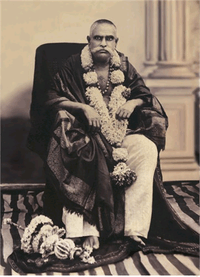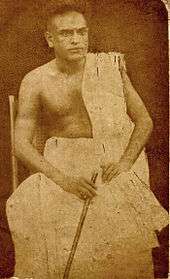C. V. Raman Pillai
| C.V. Raman Pillai | |
|---|---|
 | |
| Born |
19 May 1858 Arayoor, Travancore |
| Died |
21 March 1922 (aged 63) Trivandrum, Travancore |
| Occupation | Novelist, playwright, journalist, social activist |
| Nationality | Indian |
| Period | 1880s −1920s |
| Genre | Fiction, theatre |
| Subject | Literary, socio-cultural |
| Literary movement | Progressive Social Reform and Socio-Democratic Prigress in Governance |
| Notable works |
Historical Novels
Social Novels
Farces
|
Cannankara Velayudhan Raman Pillai (C.V.Raman Pillai) (Malayalam:സി.വി. രാമന്പിള്ള) (19 May 1858 – 21 March 1922) was one of the great Indian novelists and playwrights and pioneering playwright and journalist in Malayalam. He is often called and known as C.V.
Early life
Born in Thiruvananthapuram (Trivandrum), capital city of the erstwhile native State of Travancore, on 8 November 1858 to Neelakanta Pillai, a Sanskrit scholar and Parvathy Pillai, who were both from middle-class families and were employees at the Palace of the Maharaja of Travancore. C. V.'s mother, Parvathi Pillai, was a scion of an ancient matriarchal family. Her matriarchal ancestral family abode, was called Cannankara, the "C" in C.V. Named Raman and fondly called Ramu by near and dear ones, the boy had a traditional Sanskritized education, early in life, under his father's tutelage which included lessons in Ayurveda and even magic and Tantra. When he was 12 years old, under the patronage of Sri Kesavan Thampi,great grandson of Raja Kesava Das, a former great Dewan of Travancore, and Kaaaryakkaar (Manager) of Bhajanappura Madhom Palace, residence of the heir-apparent to the throne of the then Travancore State, Raman entered the first English school in Thiruvananthapuram and later graduated from H. H. Maharaja's College in Thiruvananthapuram, the first-ever College in Travancore, and at the end of a brilliant academic career under European Professors, Principal John Ross of Scotland and Dr. Robert Harvey of England,whose favourite disciple C.V. was, and took his B. A. Degree from the Madras University in 1881, securing the 7th rank in the Madras Presidency.
His foray into journalism was pioneering. Gifted alike in English and Malayalam, he was an early builder of Kerala's Fourth Estate. His sharp and incisive pen brought forth first, The Kerala Patriot, then the ' 'Malayali and finally the Mitabhashi.
Writing career


C.V. Raman Pillai, popularly known as C.V., is classed with the greats in Indian literature like Bankim Chandra Chatterjee in Bengali and Hari Narayan Apte in Marathi. In the grand epic sweep of his great classics, Marthandavarma, Dharmaraja and Ramarajabahadur, he is in the class of the great Vyasa. In world literature, he ranks with Dostoevsky and Shakespeare.
Modern Malayalam drama traces its origins to C.V.'s works. His very first attempt at literary creation, was the first original play in Malayalam. Candramukheevilasam was written in 1884 and was staged for four days successively in 1887 at His Highness Maharaja's College, Trivandrum. This was also the first staging of a play in Malayalam by educated amateur actors. In fact, original Malayalam drama in prose began with his eleven farces, nine of which were published. They set the tone and paved the way for the Kerala theatre that it is now.
Kerala's folklore and Kathakali became an integral part of his literary metier. He drew out myriad forgotten episodes from his country's history and the genius in him wove them into unforgettable epics. Marthandavarma, his first novel, called by him a "historical romance, which was also the first historical novel in Malayalam, was written by him in 1885 but could not be published owing to lack of finance. It was published by Addison & Co., in Madras in 1891 only after "Indulekha" by Chandu Menon was brought out in 1889 and became the first-ever original novel in Malayalam. Marthanda Varma, however, was an instant hit and editorially hailed by The Hindu of Madras, on 21 December 1891. It continues to be a popular classic even today and has gone through more than 125 editions.
For nearly twenty years from 1891, C.V. did not produce any major literary work. 1909 saw the production of his major comedy, Kurupillakalari. It was in 1913, a year after he resigned from the post of Superintendent of the Government Press, in protest against the State Government's anti-people policies that he wrote his second novel, Dharmaraja, the first of a trilogy, that he conceived on an epic scale. The novel marked him out as a master craftsman in fiction. In 1915 he wrote a social novel, Premamritam which is the first satirical fiction in Malayalam. C.V.'s masterpiece, however, is Ramarajabahadur, published in 1918 and hailed by outstanding critics as the greatest novel in Malayalam.
Exegetic dictionary
A monumental lexicographic work, an exegetic dictionary of a single author's literary works, first of its kind in any Indian language and perhaps in other world languages, has been accomplished with the publication of C. V. Vyaakhyaana Kosham in four volumes of 400-odd pages each, explaining, elucidating and interpreting in their contextual setting of all the more than seven hundred thousand words, of which a large number besides Malayalam are in Sanskrit, Tamil, Hindustani and English, used by C. V. in his four novels and nine published farces. This is also enriched by including brief critical and analytical studies of all the major and minor characters of C. V., numbering about 300.
Personal life
Pillai was relatively old, by Indian standards of that era, when he first married. He was thirty years of age when he was married to Bhageerathi Amma, who was sixteen years younger than him. The marriage was arranged by their parents in the usual Indian way, and was harmonious and respectable. Six children were born of the marriage before Bhageerthi Amma died, aged 31, in 1905. Hardly one year later, Pillai married Bhageerathi Amma's elder sister, 34-year-old Janaki Amma. This was Janaki Amma's fourth and last marriage; she had been widowed twice and divorced once before finally marrying her sister's widower. The latest (third) of her previous husbands had been the well known painter, C. Raja Raja Varma. Varma, who was the younger brother of the celebrated Raja Ravi Varma, had also died in 1905. Janaki Amma, who had no children by any of her four marriages, helped Pillai raise his children (her nephews and nieces), and survived him.
C.V. Raman Pillai died on 21 March 1922. Janaki Amma, who did not marry again, died in 1933. In 1970, the Panchayat (local authority area) of Chenkal, which includes his native village of Arayoor, was renamed C.V.R.Puram in his honour. This was done due to the heartily expressed feelings of the people living there.
Works
Novels
- Marthandavarma (1891)
- Dharmaraja (1913)
- Premamritam (1915)
- Ramarajabahadur (1918)
- Dishtadamshtram (1922) (unfinished)
- Premarishtam (1922) (unfinished)
Plays
- Candramukheevilāsam (1884) (not published)
- Mattavilāsam (1885) (not published)
- Kurupillakalari (1909)
- Tentanāmkōţţu Hariscandran (1914)
- Kaimalassanţe Kaţassikkai (1915)
- Docţarku Kiţţiya Miccam (1916)
- Cerutēn Columbus (1917)
- Panţattē Pāccan (1918)
- Pãpi Cellaņaţam Pātālam (1919)
- Kuruppinţe Tirippu (1920)
- Butler Pappan (1922)
Other works
- Videsiyamedhavitvam (1922) (a collection of editorials)
As editor in newspapers
- The Kerala Patriot (1882)
- Malayali (1886)
- Vanchiraj (1901)
- Mitabhashi (1920)
Translations
- Marthandavarma (1936, 1979)
- Dharmaraja (2009)
- Ramarajabahadur (2003)
M
Honors
A commemorative postage stamp on him was issued on 19 May 2010.[1]
See also
References
- ↑ "Stamps – 2010". Department of Posts, Government of India. Retrieved 2 August 2013.
- P. K. Parameswaran Nair, 'C.V. Raman Pillai'
- N. Balakrishnan Nair, 'Saakshaal C.V.'
- K. Ayyappa Panicker, 'C.V. Raman Pillai'
- S. Guptan Nair, 'C.V. Raman Pillai'in English
- K. Ayyappa Paniker, 'History of Malayalam Literature'
- K. M. Tharakan, 'History of Malayalam Novel'
- Kerala Govt Official Reference
- DC books reference
External links
| Wikimedia Commons has media related to C. V. Raman Pillai. |